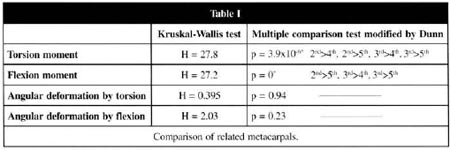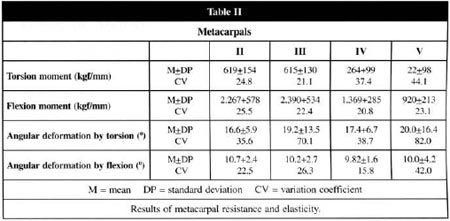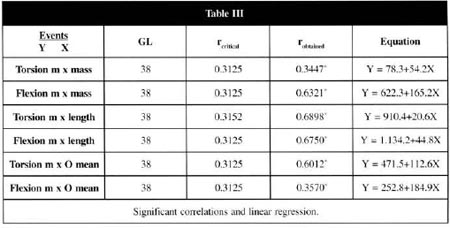

Articles - Year 2000 - Volume 15 -
Resistance to Torsion and Flexion of Human Metacarpal Bones: Experimental Study
Resistência à Torção e à Flexão de Ossos Metacarpais Humanos: Estudo Experimental
ABSTRACT
The authors studied 80 metacarpals II to V of 20 human cadaver hands with mean age of 44 years, ranging from 20 to 62 years old. 40 metacarpal bones were used in torsion tests and other 40 were used in flexion tests in mechanical universal testing machine. The authors' objective was to determine metacarpal bones resistance and to compare the accuracy of torsion and flexion testing. Resistance of metacarpal bones to flexion was approximately four times higher than to torsion. Both tests showed identical statistical accuracy. The II and m metacarpals were around 2.5 times more resistant than the IV and V ones.
Keywords: Hand; metacarpal bones; experimental study
RESUMO
Foram estudados 80 ossos metacarpais, do 2º ao 5º, de 20 mãos de cadáveres humanos formolizados, com média de idade de 44 anos, variando de 20 a 62 anos. Quarenta ossos metacarpais serviram para testes de torção e 40 outros, para teste de flexão em máquina universal de ensaios mecânicos. Objetivamos determinar a resistência dos ossos metacarpais e comparar a precisão dos ensaios de torção e de flexão. A resistência dos ossos metacarpais à flexão foi aproximadamente quatro vezes maior do que à torção. Os dois ensaios exibiram idêntica precisão estatística. O 2º e o 3º ossos metacarpais, em ambos os testes, foram cerca de duas vezes e meia mais resistentes que o 4º e o 5º.
Palavras-chave: Mão; ossos metacarpais; estudo experimental
The aim of this paper is to know the strength of the metacarpal bones in order to have elements which will be able to evaluate the dimensioning of its synthesis devices; contributing, this way, to its biomechanical improvement.
MATERIAL AND METHOD
It was used eighty II to V metacarpal bones from ten pairs of formolized cadaver hands. Five pairs of hands undergone torsion tests and the other five pairs, flexion tests. The age rate of the cadavers varied from 20 to 62 years old, with age mean of 44 ± 13.50 years. All hands came from male cadavers. Metacarpal bones were measured, weighed and verified visual and radiographically before and after the tests.
All tests were performed in a universal testing machine (Kratos K5002), equipped with electronic loading cell and graphic registration. It was chosen a 20 mm/min. loading appliance speed.
TORSION ESSAYS
For the torsion essay, it was applied a jagged wheel and a chain. A specially developed claw was firted to the jagged wheel axially, where one of the extremities of metacarpal bone was fixed. In a solidary telescopic system to the machine base, it was fixed a second claw, equal to that first one, which allowed the fixation of the other bone extremity, according to the necessary lenght to fixation. This system ensured that resistance and deformation angular measurements of metacarpal bones to be obtained by resistance/linear deformation ratio performed automatically by the machine, which allowed the graphic register, so we got load versus deformation diagrams of each test. The influence of the chain weight and attrition was determined in an empty calibration test and subtracted from the final values.
FLEXION ESSAYS
To the flexion essays, it was chosen simple flexion upon two points. These tests were performed with a centralized cleaver. These two points were fixed to a bore which also allowed calibration of useful length (metacarpal bone's length between the points). The metacarpal bones were fixed upon two iron bars, with a cylindrical rotation surface, parallel and distant from each other. The metallic cleaver is semicyllindrical, with an aperture angle of 55 degrees.
ANGULAR DEFORMATION AND MOMENTS
We acquired graphic registrations of load (kgf) versus deformation (mm) of both essays. Concerning these previous results, we calculated moments and virtual angular deformations concerning the following relations:
TORSION
Obtained relations - To stress calculation:
M = F.r, where M = torsion moment (kgf x mm); F = force result by the machine (kgf); r = D/2 = 138/3 = 69 mm, lever arm of the jagged wheel.
To torsion moment calculation:
MT = M - M', where MT = accurate torsion moment (kgf/mm); M = obtained torsion moment; M' = torsion moment caused by chain weigh and attrition.
To the torsion angular deformation:
0 = d/K, where 0 = angular deformation (in degrees), d = linear deformation (mm), K = proportionality constant (degrees/mm).
FLEXION
The useful length was L/2, with the extremity points on L/4 and 3L/4 positions, equal to the torsion essays. The flexion moment was calculated following this equation:

where F was acquired from the diagrams and the useful length, equal to the torsion essays.
With metacarpal bone upon its dorsal surface, we put the cleaver on the volar surface. The virtual flexion angle was calculated by the following expression: 0= arctg (2d/Luseful), where d = deformation, verified in the useful length, and Luseful = metacarpal bone length between the extremity points.
A 5-percent significance level was applied (p = 0.05) as statistical analysis.
DISCUSSION
Papers concerning mechanical characterization of human bones are rarely available in the literature. We did not find any publications comparing torsion and flexion tests of metacarpal bones. We have decided to perform these essays because most of long bone fractures result from torsion or flexion stresses.
We used formolized bones mainly because rupture resistance is not significantly affected by this conservation method. We verified that II to V metacarpal bones showed similar elasticity. The mean angle of torsion and flexion didn't show significant difference.
Concerning the resistance, in the torsion essay, II and III metacarpals are similar to each other and statistically major compared with IV and V metacarpals which are also similar to each other.
In the flexion essays, concerning resistance, II and III metacarpals presented similar and major compared with the IV and V ones which are similar to each other.
Peters & Koebke(2) measured torsion resistance of II to V metacarpal bones in 50 pairs of human hands. They affirmed that because of the specific position of radioulnar axis, through metacarpal extremities, human hand can be divided up into 3 functional units: thumb, index and medium, and annular and minimal. They showed that in this functional unit there are two separated intersections: one for II and III metacarpals and the other for the IV and V ones, which allows their different expression and resistance under torsion, also observed in this thesis.



Bezerra(1), in master's degree dissertation titled Torsion Resistance of Hand Flexor Tendons, concluded that surface and deep flexor tendons of 2nd and 3rd fingers are much more resistant compared with those from 4th and 5th ones.
In this study, the author verified that II and III metacarpals are more resistant than IV and V ones probably because those are recruited more frequently to greater efforts, like gathering loads. On the other hand, IV and V metacarpals are only recruited as sustentation point during various hand functions. The comparison between this thesis and that dissertation confirmed that metacarpal bone resistence is proportional to the respective flexor tendon resistance.
The torsion essays have the same variation of the flexion ones. So, we can affirm that both flexion and torsion essays present the same precision and repeatability.
It is very important to comment that flexion essays presented a fast, simple and practice technical execution compared with the torsion essays.
Metacarpal bone resistence to flexion was greater than to torsion. In the II and III metacarpals this resistance was 3.5 times greater; up to almost tive times concerning the IV metacarpal and four times the V one.
Concerning mass, length and mean diameter of metacarpal bones, the 2nd and 3rd are equivalent; so are the 4th and the 5th, forming two distinctive groups.
The mechanical characterization study of resistance and elasticity of human cadaver metacarpal bones may afford elements which can help in a more adequate choice concerning osteosynthesis materials to convenient patient's rehabilitation.
CONCLUSIONS
Metacarpal bones are nearly four times more resistant to flexion than torsion.
In both essays, II and metacarpals appeared to be 2.5 times more resistant than IV and V ones.
The results of torsion and flexion showed the same precision.
REFERENCES
1. BEZERRA RN. Estudo experimental da resistência à tração dos tendões flexores da mão. Dissertação de Mestrado, Faculdade de Medicina da Universidade de São Paulo, São Paulo, 1991.
2. PETERS D, KOEBKE J. Torsion of metacarpals II to V. Functional and clinical significance. Handchir Mikrochir Plast Chir. 1990;22:191-195
3. ROSSI JDMBA, ODA A, MIRISOLA Jr WC. Alterações mecânicas de fêmures de rato submetidos a métodos de conservação. Rev Bras Ortop. 1986;21:111-114.
4. SELKER F, CARTER DR. Scaling of long bone fracture strength with animal mass. J Biomech.1989;22:1175-1183.
I - Associate Professor of Universidade Federal de Alagoas.
II - Associate Professor of Universidade Federal de Alagoas; Head of the Plastic Surgery Service of Hospital Universitário (UFAL) and senior member of Sociedade Brasileira de Cirurgia Plástica.
III - Head of the Surgery Department of Universidade Federal de Alagoas.
IV - Head Professor of Universidade de São Paulo (USP).
V - Visiting Professor of Universidade Federal de Alagoas.
VI - Medical Student from Universidade Federal de Alagoas.
Address for correspondence:
Dept. Clínica Cirúrgica - Disciplina de Cirurgia Plástica Reconstrutora
Prof. Dr. Fernando Antônio Gomes de Andrade
Centro de Saúde (CSAU) Campus Universit. A C. Simões BR 101 Norte Km 14
57081-000 - Maceió - AL Brazil Phone/Fax: (55 82) 221-5081


 Read in Portuguese
Read in Portuguese
 Read in English
Read in English
 PDF PT
PDF PT
 Print
Print
 Send this article by email
Send this article by email
 How to Cite
How to Cite
 Mendeley
Mendeley
 Pocket
Pocket
 Twitter
Twitter